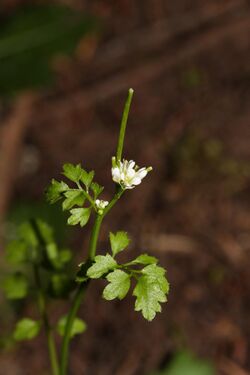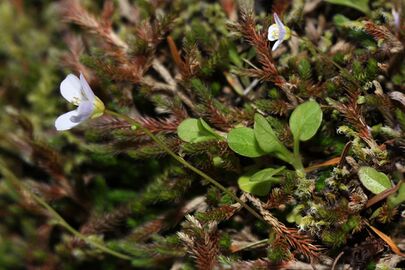Biology:Cardamine
| Cardamine | |
|---|---|

| |
| Cardamine oligosperma | |
| Scientific classification | |
| Kingdom: | Plantae |
| Clade: | Tracheophytes |
| Clade: | Angiosperms |
| Clade: | Eudicots |
| Clade: | Rosids |
| Order: | Brassicales |
| Family: | Brassicaceae |
| Genus: | Cardamine L. |
| Species | |
| Synonyms[1] | |
| |
Cardamine is a large genus of flowering plants in the mustard family, Brassicaceae, known as bittercresses and toothworts. It contains more than 200 species of annuals and perennials.[1] Species in this genus can be found in diverse habitats worldwide, except the Antarctic.[1] The name Cardamine is derived from the Greek kardaminē, water cress, from kardamon, pepper grass.[2]
Description
The leaves can have different forms, from minute to medium in size. They can be simple, pinnate or bipinnate. They are basal and cauline (growing on the upper part of the stem), with narrow tips. They are rosulate (forming a rosette). The blade margins can be entire, serrate or dentate. The stem internodes lack firmness.[clarification needed]
The radially symmetrical flowers grow in a racemose many-flowered inflorescence or in corymbs. The white, pink or purple flowers are minute to medium-sized. The petals are longer than the sepals. The fertile flowers are hermaphroditic.[citation needed]
Taxonomy
The genus Cardamine was first formally named in 1753 by Carl Linnaeus in his Species Plantarum.[3] (As of January 2019), there are 230 accepted species in Kew's Plants of the World Online database.[1] An additional 31 new species found in New Zealand were described in 2017 but are not listed in the Plants of the World Online (As of January 2019).[4][1]
The genus name Dentaria is a commonly used synonym for some species of Cardamine.
Species
Select species include:[1]
Cardamine concatenata
cutleaf toothwortCardamine nuttallii
Nuttall's toothwortCardamine trifolia
trefoil bittercress
Ecology
Uses
The roots of most species are edible raw.[6]
Some species were reputed to have medicinal qualities (treatment of heart or stomach ailments).
References
- ↑ 1.0 1.1 1.2 1.3 1.4 1.5 "Cardamine L.". Royal Botanical Gardens Kew. https://powo.science.kew.org/taxon/urn:lsid:ipni.org:names:60436526-2.
- ↑ "Definition of CARDAMINE". https://www.merriam-webster.com/dictionary/cardamine.
- ↑ "Cardamine L.". International Plant Names Index. http://beta.ipni.org/n/60436526-2.
- ↑ Heenan, Peter B. (5 December 2017). "A taxonomic revision of Cardamine L. (Brassicaceae) in New Zealand". Phytotaxa 330 (1): 1. doi:10.11646/phytotaxa.330.1.1.
- ↑ English Names for Korean Native Plants. Pocheon: Korea National Arboretum. 2015. pp. 387. ISBN 978-89-97450-98-5. http://www.forest.go.kr/kna/special/download/English_Names_for_Korean_Native_Plants.pdf. Retrieved 24 December 2016.
- ↑ Angier, Bradford (1974). Field Guide to Edible Wild Plants. Harrisburg, PA: Stackpole Books. pp. 226. ISBN 0-8117-0616-8. OCLC 799792. https://archive.org/details/fieldguidetoedib00angi/page/226/mode/2up.
Bibliography
- Taxonomic Revision of Cardamine
- Lihová, J.; Marhold, K. (2003). "Taxonomy and distribution of the Cardamine pratensis group (Brassicaceae) in Slovenia". Phyton (Horn) 43: 241–261.
- Lihová, J.; Marhold, K.; Neuffer, B. (2000). "Taxonomy of Cardamine amara in the Iberian Peninsula". Taxon 49 (4): 747–763. doi:10.2307/1223975.
- Sun, Jianqiang; Shimizu-Inatsugi, Rie; Hofhuis, Hugo; Shimizu, Kentaro; Hay, Angela; Shimizu, Kentaro K.; Sese, Jun (2020). "A recently formed triploid Cardamine insueta inherits leaf vivipary and submergence tolerance traits of parents". Front. Genet. 11: 567262. doi:10.3389/fgene.2020.567262. PMID 33133153.
External links
Wikidata ☰ Q147299 entry
 |






